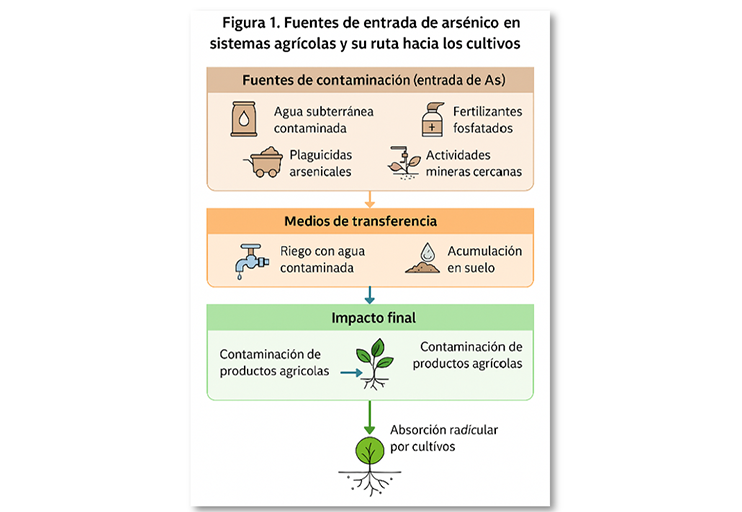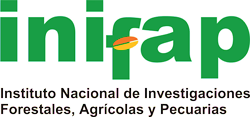Immobilized nanomaterials for arsenic removal in agricultural systems: a brief review
DOI:
https://doi.org/10.29312/remexca.v16i30.4056Keywords:
immobilized nanomaterials, remediation of As, sustainable agricultureAbstract
Arsenic contamination in agricultural soils and irrigation water poses a significant threat to crop productivity and food security. In response to this problem, the present review aimed to analyze the use of immobilized nanomaterials as a technological alternative for the efficient removal of arsenic contamination in agricultural systems. Recent studies on the application of nanomaterials, such as zero-valent iron nanoparticles, nanoclays, and metal oxides, immobilized in polymeric, ceramic, or natural matrices, were collected and evaluated. The methodology consisted of a documentary and comparative analysis of scientific research published in peer-reviewed journals, considering the parameters of adsorption capacity, removal mechanisms, optimal conditions, and efficiency in the field. The results indicated that the immobilized nanomaterials have greater stability, regenerative capacity, and lower leaching risk compared to traditional methods. In addition, successful cases were documented in Mexico, where their implementation reduced the concentration of arsenic contamination in soils and irrigation water by up to 70%. It is concluded that the use of immobilized nanomaterials is a viable and sustainable strategy for agricultural decontamination; nevertheless, more studies on their environmental impact and cost-benefit are still required for their large-scale application.
Downloads
References
Alarcón-Herrera, M. T.; Martin-Alarcon, D. A.; Gutiérrez, M.; Reynoso-Cuevas, L.; Martín-Domínguez, A.; Olmos-Márquez, M. A. and Bundschuh, J. 2020. Co-occurrence, possible origin, and health-risk assessment of arsenic and fluoride in drinking water sources in Mexico: geographical data visualization. Science of the Total Environment. 698. https://doi.org/10.1016/j.scitotenv.2019.134168.
Alka, S.; Shahir, S.; Ibrahim, N.; Ndejiko, M. J.; Vo, D. V. N. and Manan, F. A. 2021. Arsenic removal technologies and future trends: a mini review. J Clean Prod. 278. https://doi.org/10.1016/j.jclepro.2020.123805.
Almasri, D. A.; Rhadfi, T.; Atieh, M. A.; McKay, G. and Ahzi, S. 2018. High performance hydroxyiron modified montmorillonite nanoclay adsorbent for arsenite removal. Chemical Engineering Journal. 335. https://doi.org/10.1016/j.cej.2017.10.031.
Armienta, M. A.; Beltrán, M.; Martínez, S. and Labastida, I. 2020. Heavy metal assimilation in maize (Zea mays L.) plants growing near mine tailings. Environ Geochem Health. 42(8):2361-2375. https://doi.org/10.1007/s10653-019-00424-1.
Atabaki, N.; Shaharuddin, N. A.; Ahmad, S. A.; Nulit, R. and Abiri, R. 2020. Assessment of water mimosa (Neptunia oleracea Lour.) morphological, physiological, and removal efficiency for phytoremediation of arsenic-polluted water. Plants 9(11). https://doi.org/10.3390/plants9111500.
Baigorria, E.; Cano, L. and Álvarez, V. A. 2021. Nanoclays as Eco-friendly adsorbents of arsenic for water purification. In: handbook of nanomaterials and nanocomposites for energy and environmental applications. 1-4. https://doi.org/10.1007/978-3-030-36268-3-61.
Beniwal, R.; Yadav, R. and Ramakrishna, W. 2023. Multifarious effects of arsenic on plants and strategies for mitigation. Agriculture (Switzerland). 13(2). https://doi.org/10.3390/agriculture13020401.
Bhattacharya, P.; Samal, A. C.; Majumdar, J. and Santra, S. C. 2010. Arsenic contamination in rice, wheat, pulses, and vegetables: a study in an arsenic affected area of West Bengal, India. Water Air Soil Pollut 213(1-4). https://doi.org/10.1007/s11270-010-0361-9.
FAO. 2022. Producción de cultivos. Organización de las Naciones Unidas para la Alimentación y la Agricultura. FAOSTAT.
Gao, W.; Liu, Y. and Dong, J. 2021. Immobilized ZnO based nanostructures and their environmental applications. Progress in Natural Science: materials International. 31(6). https://doi.org/10.1016/j.pnsc.2021.10.006.
Gautam, R. K.; Jaiswal, N.; Singh, A. K. and Tiwari, I. 2021. Ultrasound-enhanced remediation of toxic dyes from wastewater by activated carbon-doped magnetic nanocomposites: analysis of real wastewater samples and surfactant effect. Environmental Science and Pollution Research. 28(27):36680-36694. https://doi.org/10.1007/s11356-021-13256-3.
Huerta, E. A. R. y Hernández, M. A. A. 2012. Acumulación de arsénico y metales pesados en maíz en suelos cercanos a jales o residuos mineros. Revista Internacional de Contaminación Ambiental. 28(2).
Jiménez, P. A. J.; Díaz, X.; Silva, M. L. N.; Vega, A. and Curi, N. 2023. Assessing and understanding arsenic contamination in agricultural soils and lake sediments from Papallacta rural Parish, Northeastern Ecuador, via ecotoxicology factors, for environmental embasement. Sustainability (Switzerland). 15(5). https://doi.org/10.3390/su15053951.
Kim, J. and Benjamin, M. M. 2004. Modeling a novel ion exchange process for arsenic and nitrate removal. Water Res. 38(8):2053-2062. https://doi.org/10.1016/j.watres.2004.01.012.
Kumar, R.; Patel, M. Singh, P.; Bundschuh, J.; Pittman, C. U.; Trakal, L. and Mohan, D. 2019. Emerging technologies for arsenic removal from drinking water in rural and peri-urban areas: methods, experience from, and options for Latin America. Science of The Total Environment. 694:133427. https://doi.org/10.1016/J.scitotenv.2019.07.233.
Laizu, J. 2008. Speciation of arsenic in vegetables and their correlation with inorganic phosphate level. Bangladesh J. Pharmacol. 2(2). https://doi.org/10.3329/bjp.v2i2.576.
Mitra, A.; Chatterjee, S.; Moogouei, R. and Gupta, D. K. 2017. Arsenic accumulation in rice and probable mitigation approaches: a review. Agronomy. 7(4). https://doi.org/10.3390/agronomy7040067.
Osuna-Martínez, C. C.; Armienta, M. A.; Bergés-Tiznado, M. E. and Páez-Osuna, F. 2021. Arsenic in waters, soils, sediments, and biota from Mexico: an environmental review. science of the total environment. 752. https://doi.org/10.1016/j.scitotenv.2020.142062.
Qu, G.; Zeng, D.; Chu, R.; Wang, T.; Liang, D. and Qiang, H. 2019. Magnetic Fe3O4 assembled on nZVI supported on activated carbon fiber for Cr(VI) and Cu(II) removal from aqueous solution through a permeable reactive column. Environmental Science and Pollution Research. 26(5). https://doi.org/10.1007/s11356-018-3985-8.
Rao-Vaddi, D.; Malla, R. and Geddapu, S. 2024. Magnetic activated carbon: a promising approach for the removal of methylene blue from wastewater. Desalination Water Treat. 317. https://doi.org/10.1016/j.dwt.2024.100146.
Ruíz-Huerta, E. A.; Garza Varela, A.; Gómez-Bernal, J. M.; Castillo, F.; Avalos-Borja, M.; SenGupta, B. and Martínez-Villegas, N. 2017. Arsenic contamination in irrigation water, agricultural soil and maize crop from an abandoned smelter site in Matehuala, Mexico. J. Hazard Mater. 339. https://doi.org/10.1016/j.jhazmat.2017.06.041.
Singh, S. B. and Srivastava, P. K. 2020. Bioavailability of arsenic in agricultural soils under the influence of different soil properties. SN Appl. Sci. 2(2). https://doi.org/10.1007/s42452-019-1932-z.
Toor, S. K.; Devi, P. and Bansod, B. K. S. 2015. electrochemical detection of trace amount of arsenic (III) at glassy carbon electrode modified with Au/Fe3O4 Nanocomposites. Aquat Procedia. 4:1107-1113. https://doi.org/10.1016/j.aqpro.2015.02.140.
Upadhyay, M. K.; Shukla, A.; Yadav, P. and Srivastava, S. 2019. A review of arsenic in crops, vegetables, animals and food products. Food Chem. 276. https://doi.org/10.1016/j.foodchem.2018.10.069.
WHO. 2022. Guidelines for drinking-water quality: fourth edition incorporating the first and second addenda, World Health Organization.
Xie, X.; Lu, C.; Xu, R.; Yang, X.; Yan, L. and Su, C. 2022. Arsenic removal by manganese-doped mesoporous iron oxides from groundwater: performance and mechanism. Science of the Total Environment. 806. https://doi.org/10.1016/j.scitotenv.2021.150615.
Yu, L.; Peng, X. Ni, F. Li, J. Wang, D. and Luan, Z. 2013. Arsenite removal from aqueous solutions by γ-Fe2O3-TiO2 magnetic nanoparticles through simultaneous photocatalytic oxidation and adsorption. J Hazard Mater. (246-247):10-17. https://doi.org/10.1016/j.jhazmat.2012.12.007.

Published
How to Cite
Issue
Section
License
Copyright (c) 2025 Revista Mexicana de Ciencias Agrícolas

This work is licensed under a Creative Commons Attribution-NonCommercial 4.0 International License.
The authors who publish in Revista Mexicana de Ciencias Agrícolas accept the following conditions:
In accordance with copyright laws, Revista Mexicana de Ciencias Agrícolas recognizes and respects the authors’ moral right and ownership of property rights which will be transferred to the journal for dissemination in open access. Invariably, all the authors have to sign a letter of transfer of property rights and of originality of the article to Instituto Nacional de Investigaciones Forestales, Agrícolas y Pecuarias (INIFAP) [National Institute of Forestry, Agricultural and Livestock Research]. The author(s) must pay a fee for the reception of articles before proceeding to editorial review.
All the texts published by Revista Mexicana de Ciencias Agrícolas —with no exception— are distributed under a Creative Commons License Attribution-NonCommercial 4.0 International (CC BY-NC 4.0), which allows third parties to use the publication as long as the work’s authorship and its first publication in this journal are mentioned.
The author(s) can enter into independent and additional contractual agreements for the nonexclusive distribution of the version of the article published in Revista Mexicana de Ciencias Agrícolas (for example include it into an institutional repository or publish it in a book) as long as it is clearly and explicitly indicated that the work was published for the first time in Revista Mexicana de Ciencias Agrícolas.
For all the above, the authors shall send the Letter-transfer of Property Rights for the first publication duly filled in and signed by the author(s). This form must be sent as a PDF file to: revista_atm@yahoo.com.mx; cienciasagricola@inifap.gob.mx; remexca2017@gmail.
This work is licensed under a Creative Commons Attribution-Noncommercial 4.0 International license.


